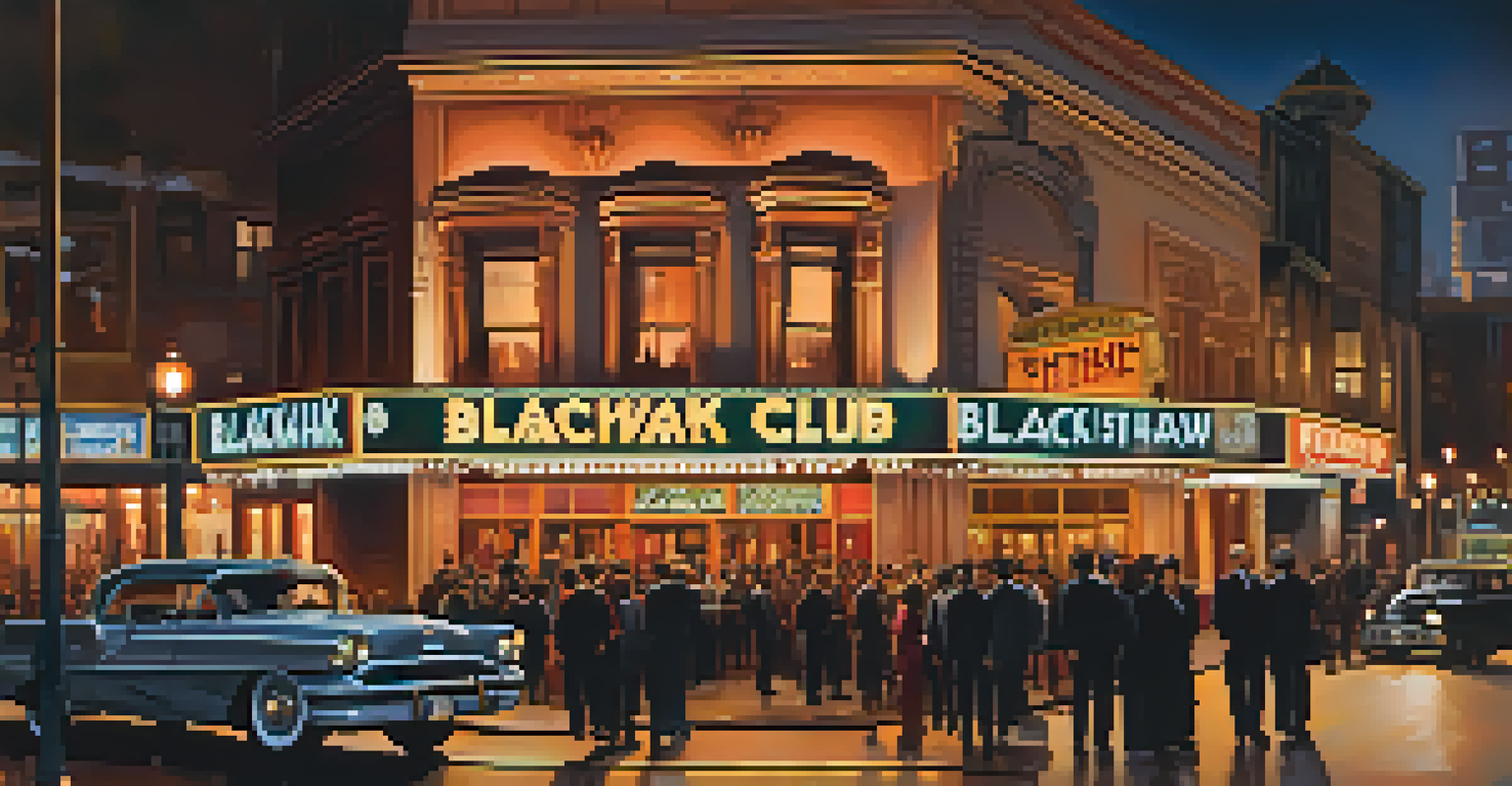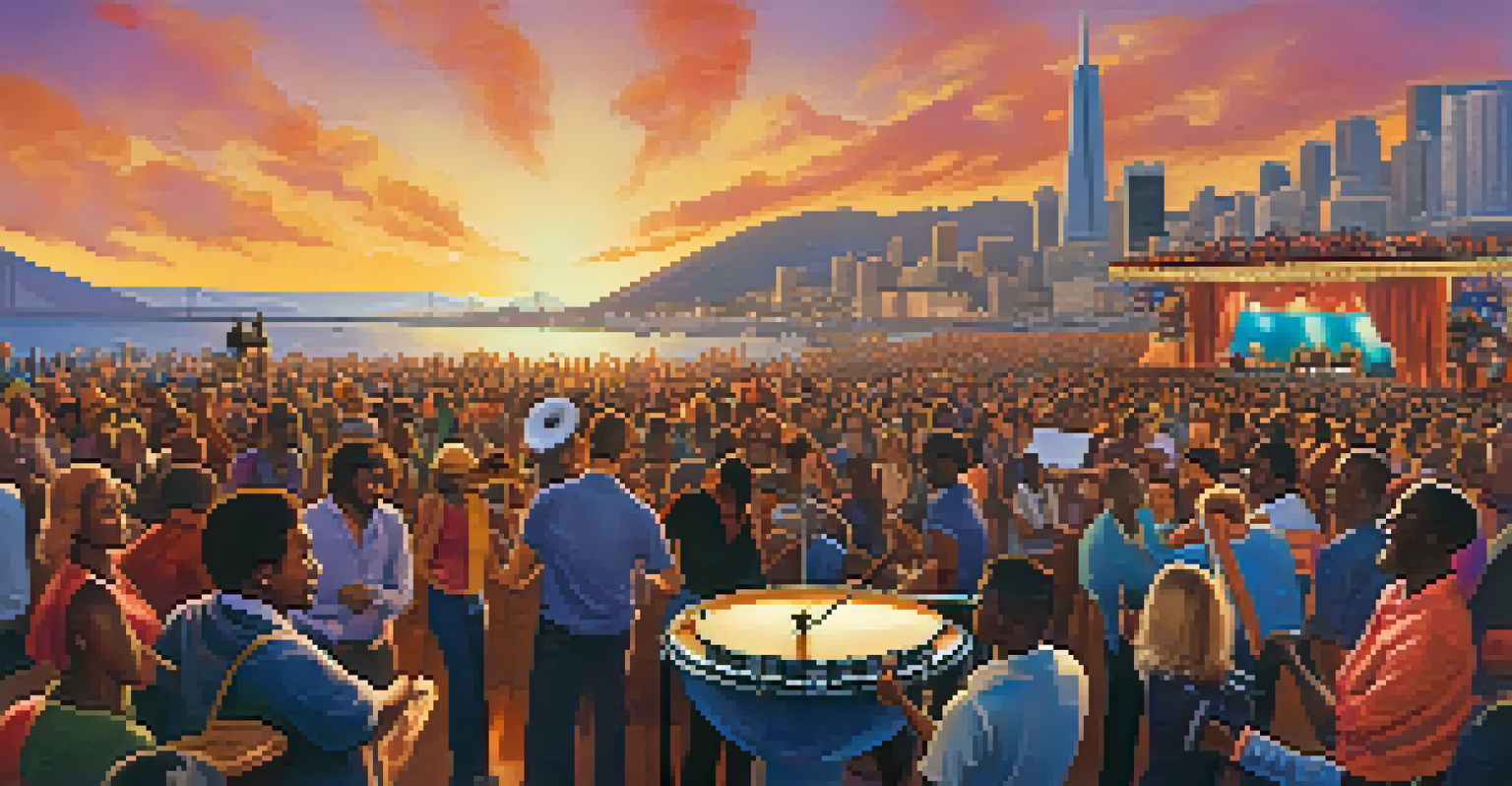San Francisco's Jazz Heritage: Influential Artists and Venues

The Birth of Jazz in San Francisco: A Historical Overview
Jazz music found its footing in San Francisco during the early 20th century, evolving from a blend of blues and ragtime. The city's diverse cultural landscape provided fertile ground for this new genre, attracting musicians from all over the country. Venues began to sprout up, turning neighborhoods like the Fillmore into hubs of jazz activity, with rhythms echoing through the streets.
Jazz is the only music in which the same note can be played night after night but differently each time.
One of the pivotal moments in this evolution occurred during the 1930s, as the Great Migration brought African American musicians to the West Coast. Their experiences and unique sounds infused local jazz with a richness that was both fresh and deeply rooted in tradition. This melding of styles set the stage for what would become a vibrant jazz scene.
As San Francisco continued to grow, so did its jazz scene, forging connections to the national movements of the time. The city's embrace of jazz not only contributed to its cultural identity but also positioned it as a key player in the larger jazz narrative across America.
Iconic Jazz Artists Who Shaped the San Francisco Sound
San Francisco has been home to numerous influential jazz artists who have left an indelible mark on the genre. One standout figure is the legendary saxophonist John Coltrane, whose innovative approaches and improvisational style captivated audiences in the 1960s. Coltrane's performances in the city are still remembered as groundbreaking, showcasing the potential of jazz as an expressive art form.

Another significant artist is the brilliant pianist and composer Dave Brubeck, who was known for his unique time signatures and engaging compositions. Brubeck's quartet gained national acclaim, often performing at venues like the popular Blackhawk club, where he helped to bring jazz to wider audiences. His work demonstrated how jazz could evolve while retaining its core improvisational spirit.
Jazz's Rich History in San Francisco
San Francisco's jazz scene blossomed in the early 20th century, fueled by a mix of cultural influences and the migration of talented musicians.
These artists and many others have not only contributed to the local scene but have also influenced jazz on a global scale. Their legacies continue to inspire new generations of musicians, ensuring that the San Francisco jazz heritage remains vibrant and relevant.
The Fillmore District: A Historical Jazz Hotspot
The Fillmore District is often referred to as the heart of San Francisco's jazz scene, particularly during the 1940s and 50s. Known as 'Harlem of the West,' this neighborhood was teeming with nightclubs and theaters that showcased some of the greatest jazz talents of the time. Venues like the Fillmore Auditorium became synonymous with jazz, hosting legendary performances that are now part of music history.
The thing about jazz is that it’s not how you play the notes, it’s how you feel the music.
Notably, the often-overlooked history of the Fillmore includes its role as a gathering place for cultural exchange. It was here that musicians of various backgrounds mingled, sharing ideas, styles, and influences. This collaborative spirit helped propel the evolution of jazz as a genre while fostering a sense of community and inclusivity.
Today, the Fillmore still honors its rich musical past, with events and festivals celebrating its heritage. As you stroll through the district, you can almost hear the echoes of saxophones and trumpets, reminding us of a time when jazz was not just music, but a way of life.
Important Venues That Shaped the Jazz Scene
San Francisco boasts several iconic venues that have played crucial roles in the development of jazz. The Blackhawk, for example, attracted top-tier talent and audiences alike, becoming a staple in the city's nightlife. Its intimate setting allowed for an up-close experience with musicians, creating memorable moments that jazz enthusiasts still talk about today.
Another legendary spot is the Great American Music Hall, known for its stunning architecture and exceptional acoustics. This venue has hosted a variety of jazz legends over the years, adding to its reputation as a premier music destination. Each performance here feels like a celebration of the genre's rich history, making it a must-visit for any jazz lover.
Influential Artists and Venues
Iconic figures like John Coltrane and Dave Brubeck, along with legendary venues, have left a lasting impact on the city's vibrant jazz culture.
These venues not only provide stages for artists but also serve as cultural landmarks, preserving the legacy of jazz in San Francisco. They remind us that live music is a vital part of our communal experience, fostering connections between artists and audiences.
The Evolution of Jazz Festivals in San Francisco
San Francisco's jazz scene has expanded beyond nightclubs to include vibrant jazz festivals that celebrate the genre’s diversity. The San Francisco Jazz Festival, established in the 1980s, has become an annual highlight, attracting both local and international talent. This event showcases a variety of styles, from traditional to contemporary, highlighting the genre’s evolution over the decades.
These festivals not only provide a platform for established artists but also spotlight emerging talent, ensuring the future of jazz remains bright. Attendees often find themselves discovering new favorites and experiencing the thrill of live performances. The sense of community at these events fosters a love for jazz that transcends generations.
Moreover, the festivals contribute to the cultural fabric of the city, drawing visitors from far and wide. They serve as a reminder that jazz is not just a genre but a communal celebration that brings people together through the power of music.
Jazz Education and Its Impact on Future Generations
Jazz education has become an integral part of San Francisco's cultural landscape, with numerous programs aimed at nurturing young talent. Institutions like the San Francisco Conservatory of Music offer courses that explore both the technical and creative aspects of jazz. By providing students with quality training, these programs ensure the continuity of the genre while fostering innovation.
In addition to formal education, local workshops and community programs encourage participation from musicians of all ages. These initiatives create opportunities for collaboration and expression, helping to build confidence and skills in aspiring artists. They emphasize the importance of creativity and improvisation, which are hallmarks of jazz music.
Education and Community in Jazz
Jazz education programs and festivals in San Francisco nurture emerging talent, ensuring the genre's evolution and community engagement.
The impact of these educational efforts can be seen in the thriving local music scene, where young musicians bring fresh perspectives to traditional sounds. As they explore the intricacies of jazz, they contribute to its ongoing evolution, ensuring that San Francisco remains a nurturing ground for future jazz talent.
The Lasting Legacy of San Francisco's Jazz Scene
The legacy of San Francisco's jazz scene is rich and multifaceted, leaving an indelible mark on both the city and the genre at large. From the iconic artists who graced its stages to the vibrant venues that hosted unforgettable performances, the city has played a crucial role in shaping jazz history. This legacy continues to inspire musicians and enthusiasts alike, fostering a deep appreciation for the art form.
Moreover, the blend of cultures and styles found within San Francisco's jazz scene has created a unique sound that resonates beyond its borders. It is a testament to the power of collaboration and creativity, showcasing how music can transcend limitations. The city's jazz heritage serves as a reminder that diversity enriches art, making it more vibrant and relatable.

As we look toward the future, San Francisco's jazz scene remains a dynamic force, continually evolving while honoring its roots. The stories, sounds, and spirits of the past intertwine with the present, ensuring that jazz remains an integral part of the city's cultural identity for generations to come.